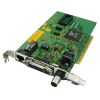10BASE2 (also known as cheapernet or thinnet) is a variant of Ethernet that uses thin coaxial cable (RG-58 or similar, as opposed to 10BASE5 cable), terminated with BNC connectors. Each segment of cable is connected to the tranceiver (which is usually built into the network adaptor) using a BNC T-connector, with one segment connected to each arm of the T. At the physical end of the network a 50 ohm terminator is required. This is most commonly connected directly to the T connector on a workstation though it doesn't technically have to be.
When wiring a 10BASE2 network, special care has to be taken to ensure that cables are properly connected to all T-connectors, and appropriate terminators are installed. Bad contacts or shorts are especially difficult to diagnose, though special (and costly) measurement devices are available. A failure at any point of the network cabling tends to prevent all communications. For this reason, 10base2 networks could be difficult to maintain and were often replaced by 10BASE-T networks, which (provided category 5 cable was used) also provided a good upgrade path to 100BASE-TX.
10BASE2 networks cannot generally be extended without breaking service temporarily for existing users and the presence of many joints in the cable also makes them very vulnerable to accidental or malicious disruption. There were propietary wallport/cable systems that claimed to avoid these problems (e.g. SaferTap) but these never became widespread, possibly due to a lack of standardisation.
The name 10BASE2 is derived from several characteristics of the physical medium. The 10 comes from the maximum transmission speed of 10 Mbit/s (millions of bits per second). The BASE stands for baseband signalling, and the 2 represents a rounded up shorthand for the maximum segment length of 185 metres.






